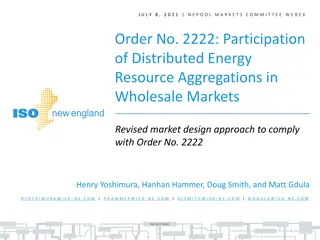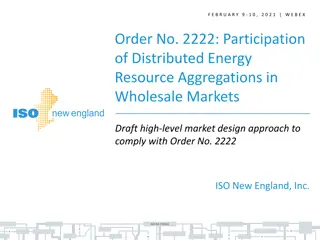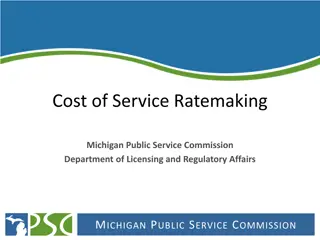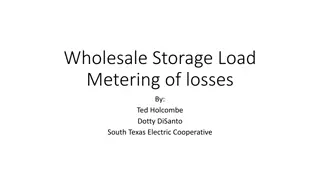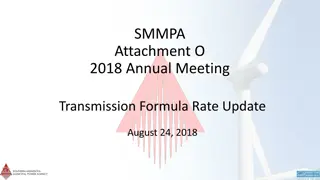Wholesale Rate Setting
This presentation covers preliminary regional rate study results, rate setting for Seattle regional wholesale contracts, and rate drivers analysis based on O&M expenses, asset costs, true-up balance, and demand projections.
Download Presentation

Please find below an Image/Link to download the presentation.
The content on the website is provided AS IS for your information and personal use only. It may not be sold, licensed, or shared on other websites without obtaining consent from the author.If you encounter any issues during the download, it is possible that the publisher has removed the file from their server.
You are allowed to download the files provided on this website for personal or commercial use, subject to the condition that they are used lawfully. All files are the property of their respective owners.
The content on the website is provided AS IS for your information and personal use only. It may not be sold, licensed, or shared on other websites without obtaining consent from the author.
E N D
Presentation Transcript
Wholesale Rate Setting Preliminary Regional Rate Study Results & Remaining Rate Study Inputs June 5, 2014 Presentation Water Supply Operating Board
Overview Preliminary Regional Rate Results Regional O&M Costs True Up Results Background on Peak Season Rate 2
Rate Setting for Seattle Regional Wholesale Contracts Regional revenue requirement is determined by three things: O&M expenses (Supply and Transmission) Asset costs (Supply and Transmission) True Up balance Allocate revenue requirement between Block and F&P customers Block customers are Cascade, Northshore, and Renton Conservation block Seattle s distribution system is an F&P customer for rate setting purposes Divide by F&P demand F&P demand is defined in contracts as 98% of water produced minus block usage = Rate per unit 3
Preliminary Rate Study Results Preliminary Results are based on: O&M from Strategic Business Plan Baseline 6 Year CIP presented at April 3, 2014 Operating Board Preliminary 2013 True Up results Demand presented at April 2, 2014 Operating Board 2014 Actual 2015 2016 2017 Preliminary Preliminary Preliminary Peak Rate ($/ccf) 2.27 2.08 2.08 2.08 Off-Peak Rate ($/ccf) 1.53 1.40 1.40 1.40 Percent Change (8)% 0% 0% 4
Rate Drivers 2015 2016 2017 Regional Cost 2.3% 4.4% 2.8% True Up Balance (2.7)% (5.6)% (3.9)% Demand (8.0)% 1.2% 1.2% Total (8.4)% 0.0% 0.0% Regional costs are increasing steadily, with a bump in 2016 for the initial close of the MLPP project A large 2014 true up balance offsets the increase in costs Increased demand over 2012-2014 is the main driver of the balance CWA s transition payment also a large factor 5
Rate Drivers, continued Besides creating a positive true up balance, the increase in demand means a decrease in rates as we step from one demand line to the other Projected Wholesale Demand including Seattle as wholesale 50,000,000 40,000,000 8% decrease in rates Annual ccf 2011 projection, used to set 12-14 rates 30,000,000 Actuals 2014 projection, used to set 15-17 rates 20,000,000 2010 2011 2012 2013 2014 2015 2016 2017 6
Northshore Fixed Block Northshore s block and true up balances are driven by changes in cost only Decrease in 2015 due to New Supply Assets, which are in FCs for F&P contracts rather than rates 2014 Actual 2015 2016 2017 Preliminary Preliminary Preliminary Fixed Block ($M) 5.2 5.1 5.3 5.5 Prior Year True Up ($M) 0.2 0.2 TBD TBD Total ($M) 5.4 5.3 TBD TBD 7
Rate Setting for Seattle Regional Wholesale Contracts Regional revenue requirement is determined by three things: O&M expenses (Supply and Transmission) Asset costs (Supply and Transmission) True Up balance Allocate revenue requirement between Block and F&P customers Block customers are Cascade, Northshore, and Renton Conservation block Seattle s distribution system is an F&P customer for rate setting purposes Divide by F&P demand F&P demand is defined in contracts as 98% of water produced minus block usage = Rate per unit 8
Regional O&M Regional O&M is determined using an index system The initial amount for each category of cost (supply and transmission) was specified in the contracts. This is the base cost for each category Each of these amounts are then increased or decreased each year based on the total costs in index activities which were also set in the contracts (Exhibit IX) 9
Regional O&M Cost History & Projections 11
Rate Setting for Seattle Regional Wholesale Contracts Regional revenue requirement is determined by three things: O&M expenses (Supply and Transmission) Asset costs (Supply and Transmission) True Up balance Allocate revenue requirement between Block and F&P customers Block customers are Cascade, Northshore, and Renton Conservation block Seattle s distribution system is an F&P customer for rate setting purposes Divide by F&P demand F&P demand is defined in contracts as 98% of water produced minus block usage = Rate per unit 12
Regional True Up Projected 2014 Year Ending true up balance is the beginning point for the 2015-2017 rate study 2013 True Up currently being reviewed Includes cumulative effect of prior year revenue adjustments 2014 revenues and costs based on same demand projection and O&M and CIP inputs as rate study Amounts just happen to be identical to 2013 13
Regional True Up 2013 2014 Beginning Balance $(6.5M) $ 5.3 + F&P Revenues 78.1 78.1 + CWA Transition Payment 5.0 + Prior Year Revenue Adjustments (0.7) - Regional Costs 70.6 70.6 = Ending Balance $ 5.3M $ 12.7M 14
Rate Setting for Seattle Regional Wholesale Contracts Regional revenue requirement is determined by three things: O&M expenses (Supply and Transmission) Asset costs (Supply and Transmission) True Up balance Allocate revenue requirement between Block and F&P customers Block customers are Cascade, Northshore, and Renton Conservation block Seattle s distribution system is an F&P customer for rate setting purposes Divide by F&P demand F&P demand is defined in contracts as 98% of water produced minus block usage = Rate per unit Rate Design 15
Seasonal Component to F&P Rates Contracts say that rates should have a seasonal differential to encourage the efficient use of water, conservation and the timely development of new environmentally responsible water sources MIT Agreement requires Seattle to encourage conservation by wholesale customers and a seasonal rate is one method for this Peak Season ratio is not necessarily cost based 16
Two Views of Seasonal Differential Ratio decreased when growth charge expired Difference has increased as rates have increased 17
Seasonal Differential for 2015-2017 Ratio being held constant Difference decreases due to decrease in rates 18
Next Steps and Targeted Dates Richard Cuthbert to finish review, targeting these dates July 10th Operating Board presentation End of July for delivery of written report Thirty days after independent review is finished, formal transmittal of proposal to Operating Board Includes Seattle s Rate Study Summary document Targeting Sept 4th meeting Begin Seattle City Council process Targeting January 1, 2015 effective date 19
















